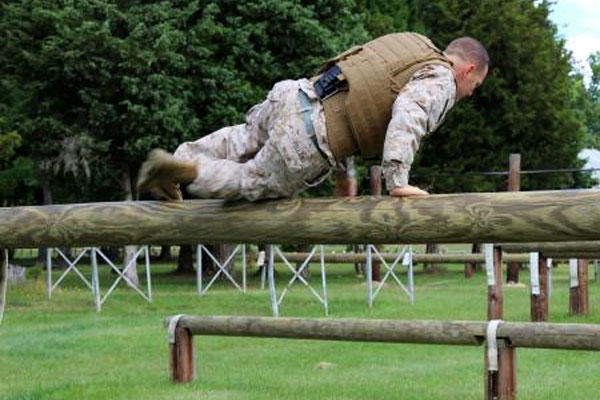QUANTICO, Va. - Marines come in all sizes—big, small, short and tall—so when it comes to Marine Corps body armor, a one-size-fits-all approach is not the answer. Marine Corps Systems Command’s Individual Armor team understands that and is doing its best to accommodate Marines of all sizes and keep them safe on the battlefield.
Sizing for body armor is based on the “fifth to ninety-fifth” percentile of Marines, which means the current sizes fit about 90 percent of the men and women in the Marine Corps, said Maj. James Pelland, Individual Armor Team lead. The team saw an opportunity to accommodate the portion of Marines who found the traditional sizing was not a comfortable fit—especially in the Improved Modular Tactical Vest.
“Based on our latest measurements of a large population set of the Marine Corps, we saw that additional sizes would benefit [smaller stature] Marines,” Pelland said. “If something is made to fit you better, you don’t have to expend extra energy struggling with it. Energy loss equates to fatigue, less functionality and less lethality. We believe in increasing Marine mobility and performance. That’s what we’re focused on.”
Although the data provided insight into the sizing issue, Pelland said the team—part of Infantry Weapon Systems’ Infantry Combat Equipment product management office—also needed to know what Marines thought about the armor. In the spring, the team conducted a web-based survey to poll Marines for ideas about how to improve the fit of existing body armor and innovations for the next generation.
“We didn’t stop there,” Pelland said. “We also conducted an attribute workshop with Marines at Camp Pendleton—including smaller stature male and female Marines. They confirmed what we thought—it wasn’t as much a male-female issue as a stature issue that’s related to the length of the torso.”
As a result of the findings, MCSC will procure nearly 3,800 IMTVs in sizes small-short, medium-short and large-short later this year—enough to outfit smaller stature Marines for the remainder of operations in Afghanistan.
The Next Generation of Body Armor
As part of the same workshop in May, the armor team also had Marines try four prototypes of the next generation body armor, the Modular Scalable Vest, and provide feedback on the designs.
“Right now, Marines go to war with a multiple-vest strategy,” Pelland said. “Commanders have to choose which vest their Marines will wear based on the situation on the ground.”
Marines in Afghanistan currently have a choice between the IMTV, fielded in 2011, and the newest body armor vest, the Plate Carrier, which is still being fielded. The IMTV provides more protection than the PC, which is lighter, cooler, less restrictive and more frequently worn by Marines in the field.
“So we set out about a year and half ago to develop a single modular, scalable vest that builds from the plate carrier all the way up to the IMTV,” Pelland said, "This gives commanders more choices in terms of armor protection levels to better adjust to the mission at hand.”
The modular, scalable vest, or MSV, will combine attributes from the IMTV and PC, and allow Marines to attach and detach components based on their needs. It is being developed by the armor team and is currently in the design review phase.
The team is working closely with engineers from the Army’s Natick Soldier Research, Development and Engineering Center and designers from the Navy’s Clothing and Textile Research Facility to make corrections and refinements to the vest. Pelland’s team also meets monthly with the Army’s Soldier Protective Equipment Program Management Office where both groups share information and design ideas.
Another innovative concept for the MSV is the addition of a central load management and distribution system—modeled after the human spine—that is inserted into the back of the vest to help more evenly distribute the weight Marines carry from their shoulders to their hips.
“Body armor alone can weigh 30 to 50 pounds; even more when Marines attach a combat load—grenades, magazines filled with ammunition, etc.,” Pelland said. “So, we’ve developed prototype [load distribution] systems that are now being tested in a lab. We’re hoping a smart load management system will effectively reduce the energy expenditure, and risk of fatigue and injury.”
A research and development effort is also underway to produce plates—the small arms protective inserts for the vest—with the same or less weight as the existing plates, but with increased performance, Pelland said. The vest will also include an improved quick-release feature so Marines can shed the gear quickly, if necessary. MCSC plans to procure the MSV in the next two years.
“Sizing and fit will be critical considerations for the MSV as well,” Pelland said. “It may mean developing new sizes for the vest and possibly the plates, but our overall goal is to size the MSV and its components in order to give Marines both the mobility and protection they need.”
The Best is Yet to Come
The idea in the future is to design all the gear and equipment a Marine wears and carries–body armor, weapons, communications equipment, power sources, etc.—as a system, Pelland said. The concept, called Modular Scalable Protective System, was developed more than a year ago and is a combined initiative including MCSC, Combat Development and Integration, Marine Corps Operational Test and Evaluation Activity, Marine Corps Intelligence Agency, the Army, and other government and industry stakeholders.
“All the program and product offices at Marine Corps Systems Command integrate and form a system that supports the Marine,” he said. “The whole is stronger than its individual parts. That’s the idea behind MSPS.”
MCSC serves as the Department of the Navy’s systems command for Marine Corps ground weapon and information technology system programs. It is also the Marine Corps commandant's agent for acquisition and sustainment of systems and equipment used to accomplish the warfighting mission.
The MSPS concept supports that mission. It is an opportunity for increased collaboration, integration and communication, Pelland said. It encourages the acquisition community to use logical relationships between certain pieces of gear to make the best decisions when equipping Marines.
“Marines carry our decisions; what we build goes directly on their skin,” he said. “I believe in [making the load] lighter. But, I believe we can do so through a ‘system of systems approach,’ affecting the weight at the requirement [stage]. We can smartly group certain pieces of gear the Marine has to carry, and design them together as a system. I believe that’s where we’re going to get true weight savings... and also where we’re going to get unbelievable interoperability. We’re not quite there yet, but just wait. There is much more to come.”


























